Wildflowers of the Adirondacks:
Tall Meadow Rue (Thalictrum pubescens)
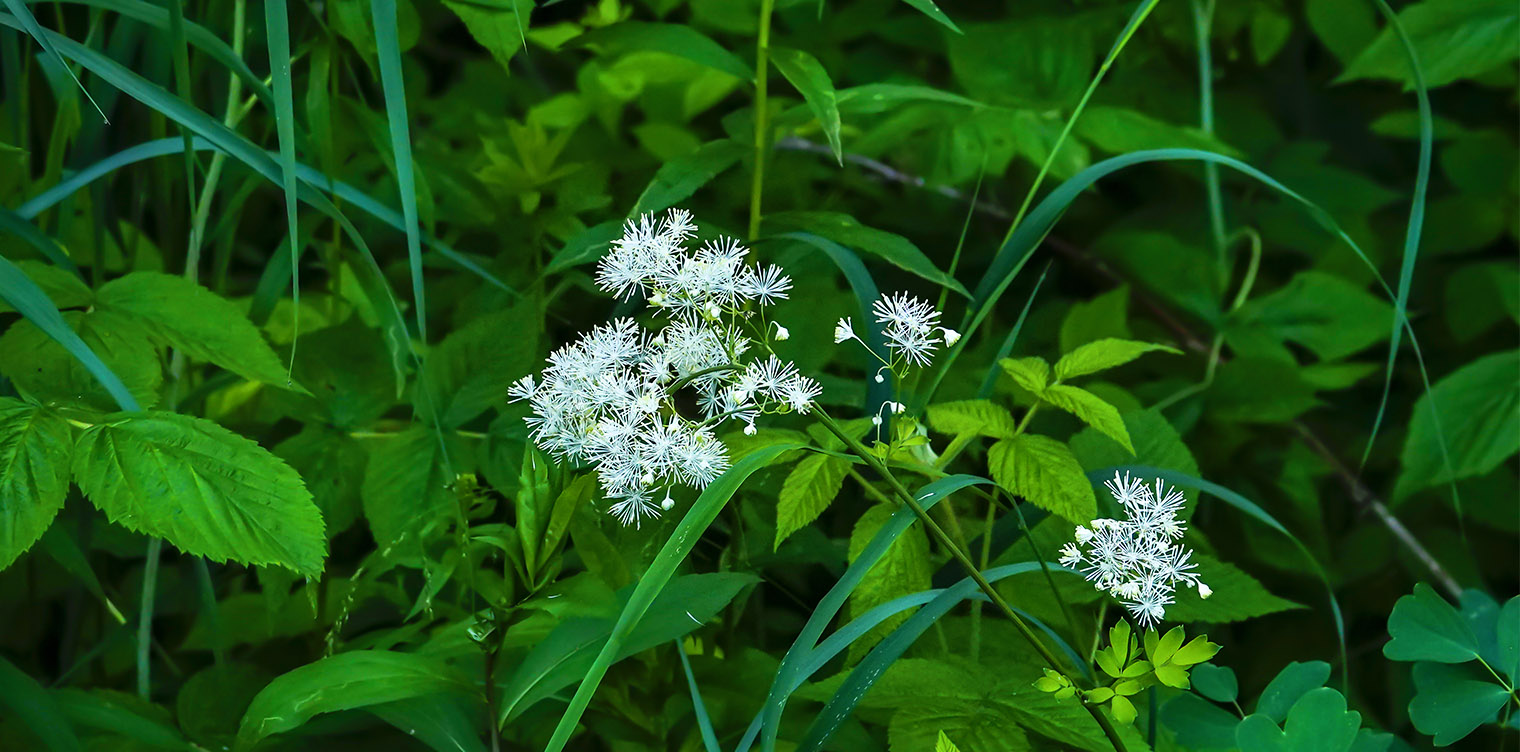
Tall Meadow Rue (Thalictrum pubescens) is a native wetland wildflower that grows in the Adirondack Mountains of upstate New York and produces feathery white flowers from late June through August.
Tall Meadow Rue is a member of the Ranunculaceae (Buttercup) family. It is part of the Thalictrum (Meadow-rue) genus. This species is one of six members of the Thalictrum genus found in the Adirondack Park. The others are:
- Purple Meadow Rue (Thalictrum dasycarpum, a nonnative species which has been documented only in Essex County)
- Early Meadow Rue (Thalictrum dioicum)
- Skunk Meadow Rue (Thalictrum revolutum)
- Rue Anemone (Thalictrum thalictroides, which has been documented only in Washington County)
- Veiny Meadow Rue (Thalictrum venulosum, which has been documented only in Essex and Clinton counties)
Other non-scientific names for this species include King of the Meadow, King-of-the-Meadow, Tall Meadow-rue, Late Meadow-rue, Meadow-weed, Muskrat-weed, Silver-weed, and Quicksilver-weed.
Identification of Tall Meadow Rue
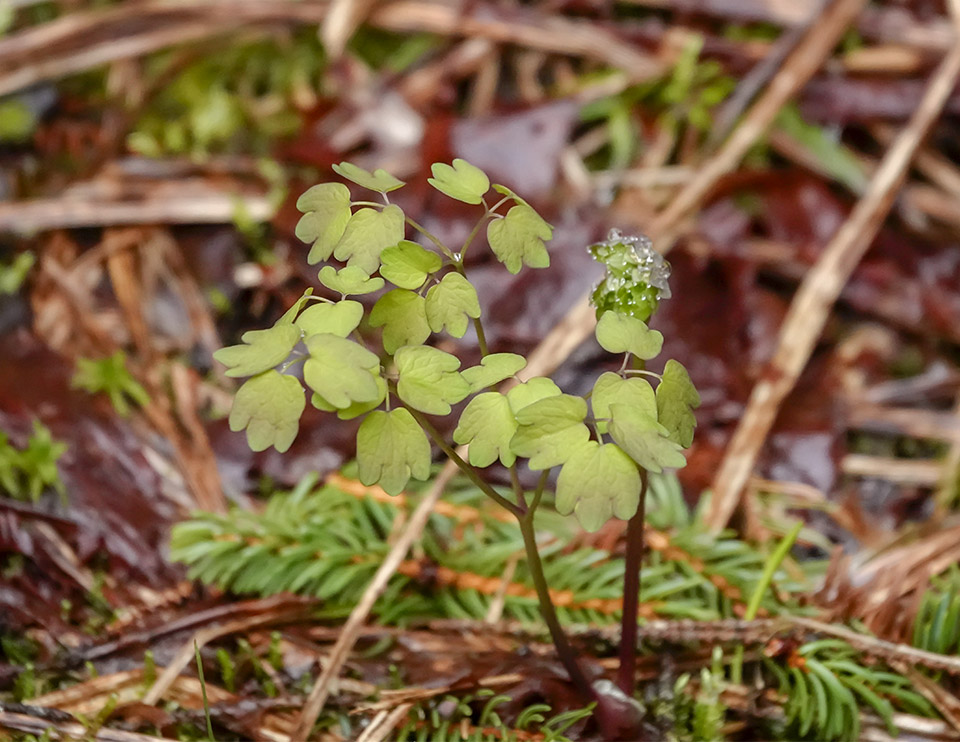
Tall Meadow Rue, as the name implies, is a tall (2-6 feet high) perennialPerennial: A n herbaceous plant that lives for more than two growing seasons. Perennial plants grow and bloom over spring and summer, die back every fall and winer, and then return in the spring from their rootstock. plant. It grows from rhizomes Rhizome: The modified subterranean stem of a plant that sends out roots and shoots from its nodes. Rhizomes are also called creeping rootstalks and rootstocks. and has stout stems.
Rhizome: The modified subterranean stem of a plant that sends out roots and shoots from its nodes. Rhizomes are also called creeping rootstalks and rootstocks. and has stout stems.
The leaves of Tall Meadow Rue are compound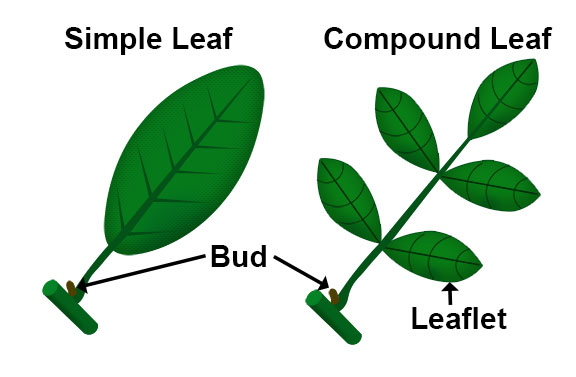 Compound Leaf: A leaf that is divided to the midrib, with distinct, expanded portions called leaflets., meaning that they are divided into leaflets.
Compound Leaf: A leaf that is divided to the midrib, with distinct, expanded portions called leaflets., meaning that they are divided into leaflets.
- The leaflets are about an inch long.
- The leaflets are bluish to olive green and end with two to three shallow lobes
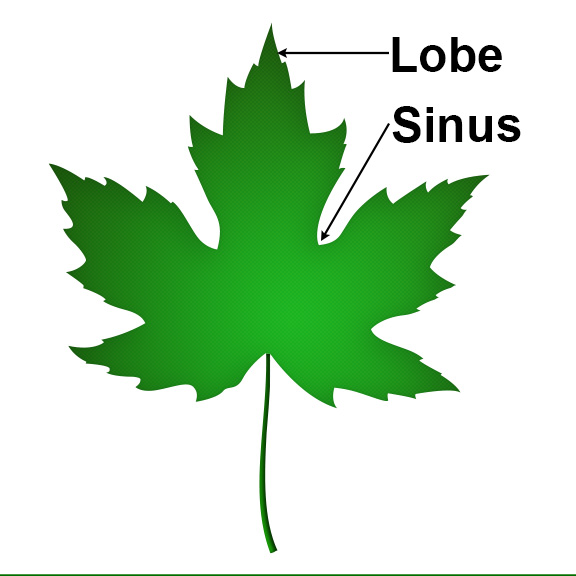 Lobe: A projection from an edge of a plant structure (such as a leaf), larger than a tooth. Lobed leaves are leaves with distinct protrusions, either rounded or pointed..
Lobe: A projection from an edge of a plant structure (such as a leaf), larger than a tooth. Lobed leaves are leaves with distinct protrusions, either rounded or pointed.. - The leaflets are glabrous Glabrous: The surface of a stem or leaf that is smooth and hairless., meaning that they are smooth, lacking hair or bristles.
- The leaves are arranged on the stem in an alternate
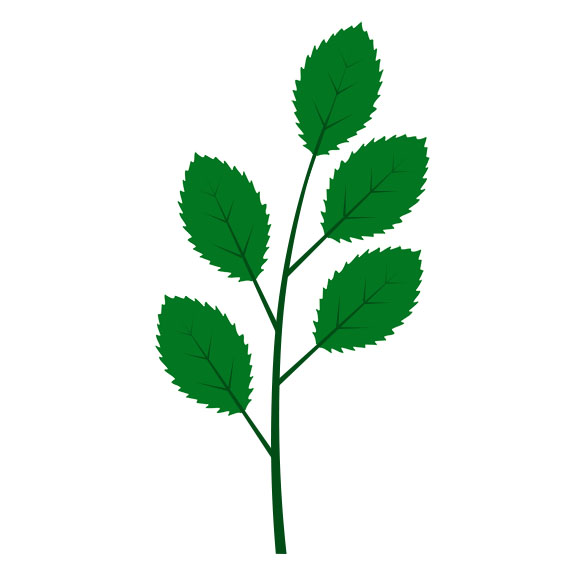 Alternate: An arrangement of leaves (or buds) on a stem (or twig) in which the leaves emerge from the stem one at a time. This often makes the leaves appear to alternate on the stem. fashion, meaning that there are two leaves per node. In late summer and early fall, the leaves turn an attractive shade of yellow or pink.
Alternate: An arrangement of leaves (or buds) on a stem (or twig) in which the leaves emerge from the stem one at a time. This often makes the leaves appear to alternate on the stem. fashion, meaning that there are two leaves per node. In late summer and early fall, the leaves turn an attractive shade of yellow or pink.
Tall Meadow Rue flowers are arranged in flower clusters (panicles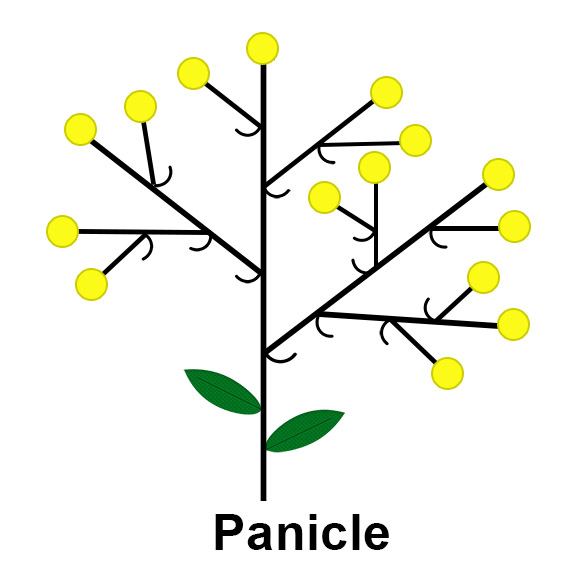 Panicle: A branched, indeterminate flower cluster (inflorescence) with individual flowers on stalks (pedicels). ). The individual flowers are white and starry. They are about ⅓ inch across and have no petals
Panicle: A branched, indeterminate flower cluster (inflorescence) with individual flowers on stalks (pedicels). ). The individual flowers are white and starry. They are about ⅓ inch across and have no petals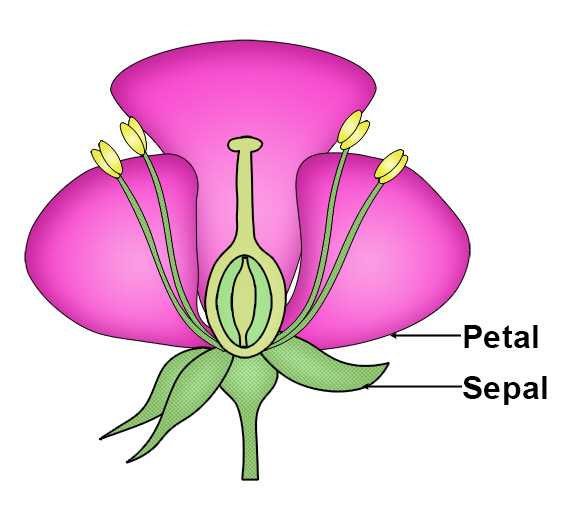 Petals: Modified leaves that surround the reproductive parts of flowers. Petals are often brightly colored or unusually shaped to attract pollinators.. The white color is from the white filaments of the stamens
Petals: Modified leaves that surround the reproductive parts of flowers. Petals are often brightly colored or unusually shaped to attract pollinators.. The white color is from the white filaments of the stamens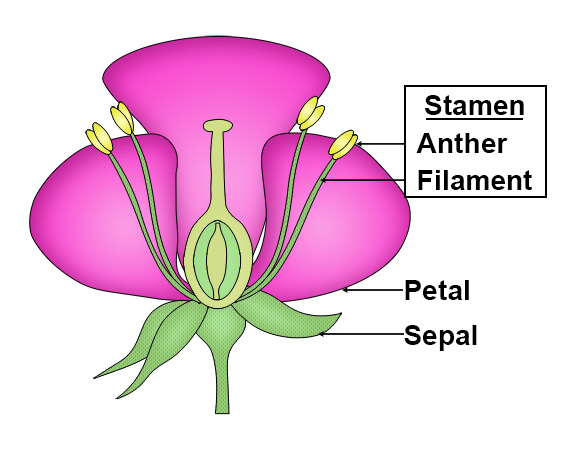 Stamen: The male part of the flower, made up of the filament and anther.. These numerous thread-live stamens are erect and give the blossoms a misty quality.
Stamen: The male part of the flower, made up of the filament and anther.. These numerous thread-live stamens are erect and give the blossoms a misty quality.
The bloom time for Tall Meadow Rue throughout its range is from mid-June through September. In the Adirondacks, flowering is usually from late June through August. Most iNaturalist observations of flowering Tall Meadow Rue within the Adirondack Park Blue Line are from July through mid-August.
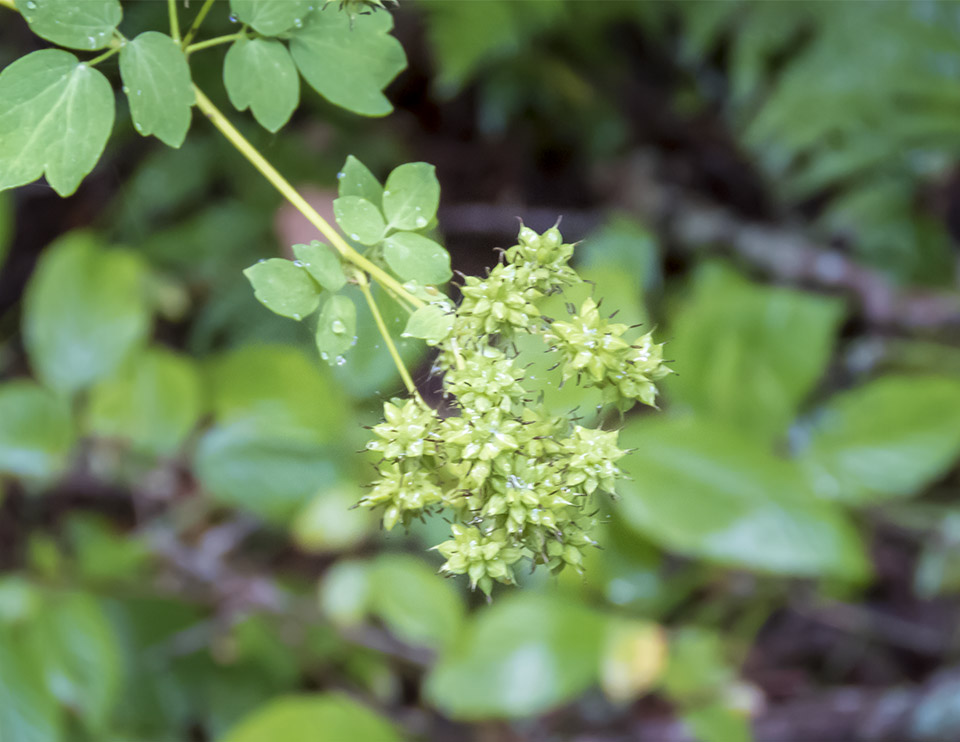
Tall Meadow Rue flowers are followed by fruit, which appears in seed-like rounded clusters. The clusters change from white to purplish, becoming light green, then darker green. As the fruits mature, the ball-shaped head of seeds finally turns brown.
Keys to identifying Tall Meadow Rue and distinguishing it from other species that occur in the Adirondacks include the nature of the flowers and the shape of the leaves. Early Meadow Rue (Thalictrum dioicum L.) also has loose clusters of dangling flowers, but it flowers earlier that Tall Meadow Rue; and the yellowish stamens droop, in contrast to the white, erect stamens of Tall Meadow Rue. In addition, the leaflets have four or more lobes at the ends. In any event, Early Meadow Rue usually is found in nonwetlands, such as mesic hardwood forests, while Tall Meadow Rue is a wetland plant normally found in poorly drained soils in swamps and steam or lake edges.
Habitat differences also help distinguish Tall Meadow Rue from two other plants with somewhat similar leaves. Wild Columbine also has compound leaves, with lobed leaflets, but with more lobes than the leaflets of Tall Meadow Rue. Blue Cohosh also has compound leaves with lobed leaflets, but the leaves tend to have a more bluish cast. Both of these plants are generally found in better-drained soil than Tall Meadow Rue; and, in any event, both have very different shaped flowers, so are unlikely to be confused with Tall Meadow Rue when flowering.
Uses of Tall Meadow Rue
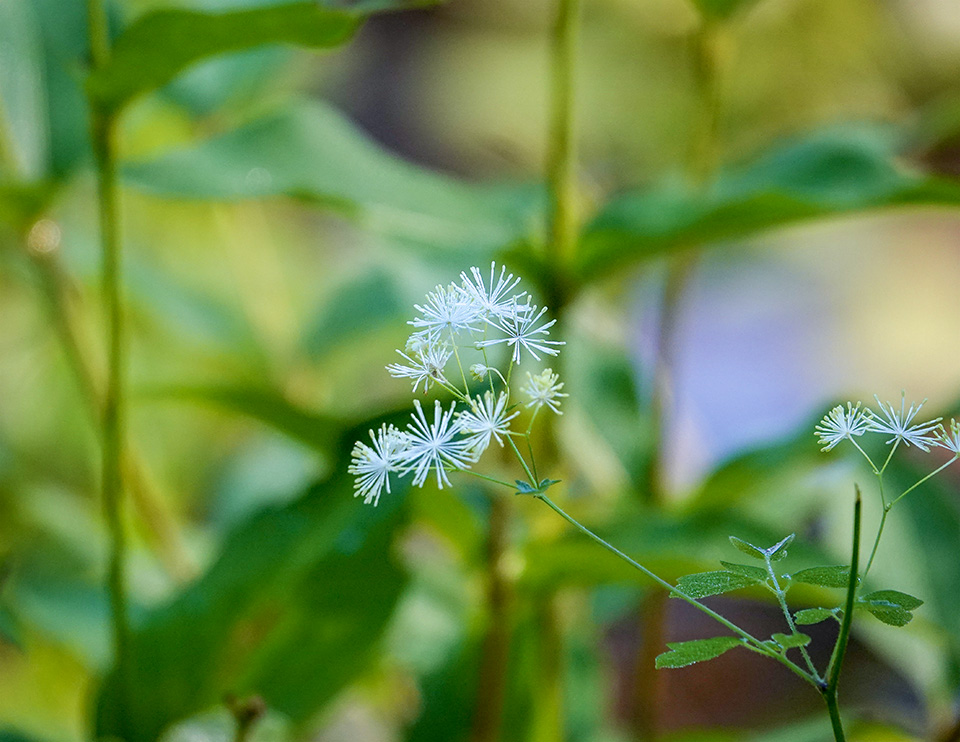
Tall Meadow Rue has very limited uses. The Iroquois used an infusion of the plant to treat nosebleeds and an infusion of the roots as a gall medicine. The Montagnais reportedly used the leaves to flavor salmon.
Wildlife Value of Tall Meadow Rue
Tall Meadow Rue is chiefly of value to insects. The flowers are said to be constantly visited by bees and butterflies. In addition, a number of beetles reportedly feed on the plant, as do larvae of the Straight-lined Looper. A study of the host plants of butterflies and moths collected in the Adirondack Park found that larvae from several other species of moth used Tall Meadow Rue as a host plant, including the Canadian Owlet, Pink-patched Looper Moth, Hitched Arch, and Speckled Cutworm.
Distribution of Tall Meadow Rue
Tall Meadow Rue is found in most states in the eastern US (with the exception of Florida) and the southeastern Canadian provinces. The plant is listed as threatened in Indiana.
Tall Meadow Rue is found in nearly all counties in New York State. Its presence has been documented by vouchered plant specimens for all counties within the Adirondack Park except Clinton County.
Habitat of Tall Meadow Rue
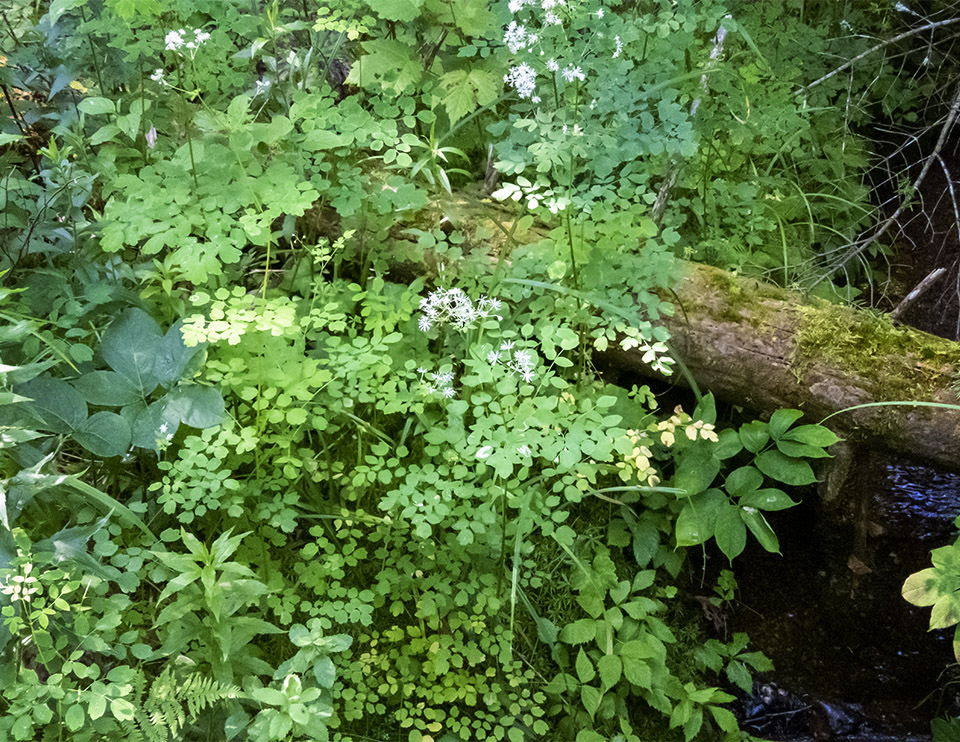
Throughout its range, Tall Meadow Rue can grow in full sun to deep shade. Its preference is for moist, moderately fertile, organically rich soils in part shade or dappled sun.
Tall Meadow Rue is classified as a Faculative Wetland plant (FACW). This means that it usually occurs in wetlands, but may occur in nonwetlands.
Tall Meadow Rue throughout its range is found in rich fens, swamps, marshes, low thickets, wet meadows, and along the edges of meandering streams and rivers. It can also be found at wet peripheral areas of fens and bogs and along the marshy shorelines of lakes.
In the Adirondack Park, Tall Meadow Rue is found in several wetland ecological communities, including:
Among the trails covered here, Tall Meadow Rue can be found in wetland areas along the Black Pond Trail at the Paul Smith's College VIC, the Jackrabbit Trail at River Road, the Bloomingdale Bog Trail, and the Heart Lake Trail. Look for Tall Meadow Rue growing near Spotted Touch-me-not (Impatiens capensis), Spotted Joe Pye Weed (Eutrochium maculatum), White Turtlehead (Chelone glabra), and Cinnamon Fern (Osmunda cinnamomea).
References
Michael Kudish. Adirondack Upland Flora: An Ecological Perspective (The Chauncy Press, 1992), p. 110.
New York Flora Association. New York Flora Atlas. Tall Meadow Rue. Thalictrum pubescens. Retrieved 10 October 2019.
Integrated Taxonomic Information System. Thalictrum pubescens. Retrieved 10 October 2019.
United States Department of Agriculture. The Plants Database. King of the Meadow. Thalictrum pubescens Pursh. Retrieved 10 October 2019.
Flora of North America. Thalictrum pubescens. Retrieved 10 October 2019.
NatureServe Explorer. Online Encyclopedia of Life. Tall Meadowrue. Thalictrum pubescens. Retrieved 10 October 2019.
Native Plant Trust. Go Botany. Tall Meadow-rue. Thalictrum pubescens Pursh. Retrieved 10 October 2019.
New York State. Department of Environmental Conservation. New York Natural Heritage Program. Ecological Communities of New York State. Second Edition (March 2014), pp. 48-49, 55-56, 57-58, 59, 67, 75-76. Retrieved 17 October 2015.
New York Natural Heritage Program. 2021. Online Conservation Guide for Riverside Ice Meadow. Retrieved 7 July 2021.
New York Natural Heritage Program. 2021. Online Conservation Guide for Rich Hemlock-Hardwood Peat Swamp. Retrieved 7 July 2021.
New York Natural Heritage Program. 2021. Online Conservation Guide for Rich Shrub Fen. Retrieved 7 July 2021.
New York Natural Heritage Program. 2021. Online Conservation Guide for Rich Sloping Fen. Retrieved 7 July 2021.
New York Natural Heritage Program. 2021. Online Conservation Guide for Sedge Meadow. Retrieved 7 July 2021.
New York State. Adirondack Park Agency. Preliminary List of Species Native Within the Adirondack Park Listed Alphabetically by Scientific Name and Sorted by Habit. Volume 1. Updated 10.23.2006, p. 39. Retrieved 26 January 2017.
Connecticut Botanical Society. Tall Meadow Rue. Thalictrum pubescens Pursh. Retrieved 10 October 2019.
Illinois Wildflowers. Plant-Feeding Insect Database. Thalictrum pubescens. Tall Meadow Rue. Retrieved 10 October 2019.
Missouri Botanical Garden. Thalictrum pubescens. Retrieved 11 October 2019.
Lady Bird Johnson Wildflower Center. King Of The Meadow. Thalictrum pubescens. Retrieved 10 October 2019.
Online Encyclopedia of Life. King Of The Meadow. Thalictrum pubescens Pursh. Retrieved 10 October 2019.
iNaturalist. Tall Meadow-Rue. Thalictrum pubescens. Retrieved 7 July 2021
iNaturalist. Adirondack Park Observations. Tall Meadow-Rue. Thalictrum pubescens. Retrieved 7 July 2021.
Anne McGrath. Wildflowers of the Adirondacks (EarthWords, 2000), pp. 15, 40.
Roger Tory Peterson and Margaret McKenny. A Field Guide to Wildflowers. Northeastern and North-central North America (Houghton Mifflin Company, 1968), pp. 72-73.
Meiyin Wu & Dennis Kalma. Wetland Plants of the Adirondacks: Herbaceous Plants and Aquatic Plants (Trafford Publishing, 2011), p. 134.
Ronald B. Davis. Bogs & Fens. A Guide to the Peatland Plants of the Northeastern United States and Adjacent Canada (University Press of New England, 2016), pp. 180-181.
Timothy Coffey. The History and Folklore of North American Wildflowers (FactsOnFile, 1993), p. 22.
Ruth Schottman. Trailside Notes. A Naturalist's Companion to Adirondack Plants (Adirondack Mountain Club, 1998), pp. 53-56.
William Carey Grimm. The Illustrated Book of Wildflowers and Shrubs (Stackpole Books, 1993), pp. 108-109.
Wilbur H. Duncan and Marion B. Duncan. Wildflowers of the Eastern United States (The University of Georgia Press, 1999), p. 15, plate 53.
National Audubon Society. Field Guide to North American Wildflowers. Eastern Region. (Alfred A. Knopf, 2001), p. 740, Plate 164.
University of Michigan. Native American Ethnobotany. A Database of Foods, Drugs, Dyes and Fibers of Native American Peoples, Derived from Plants. King Of The Meadow. Thalictrum pubescens Pursh. Retrieved 11 October 2019.
Butterflies and Moths of North America. Pink-Patched Looper Moth. Eosphoropteryx thyatyroides. Retrieved 11 October 2019.
Iowa State University. BugGuide. Pseudeva purpurigera. Straight-lined Looper. Retrieved 11 October 2019.
Iowa State University. BugGuide. Calyptra canadensis. Canadian Owlet. Retrieved 11 October 2019.
Iowa State University. BugGuide. Eosphoropteryx thyatyroides. Pink-patched Looper Moth. Retrieved 11 October 2019.
Timothy L. McCabe. Atlas of Adirondack Caterpillars. With a Host List, Rearing Notes and a Selected Bibliography of Works Depicting Caterpillars (New York State Museum Bulletin No. 470, 1991). Retrieved 22 February 2017.
Charles H. Peck. Plants of North Elba (Bulletin of the New York State Museum, Volume 6, Number 28, June 1899), p. 72. Retrieved 22 February 2017.
